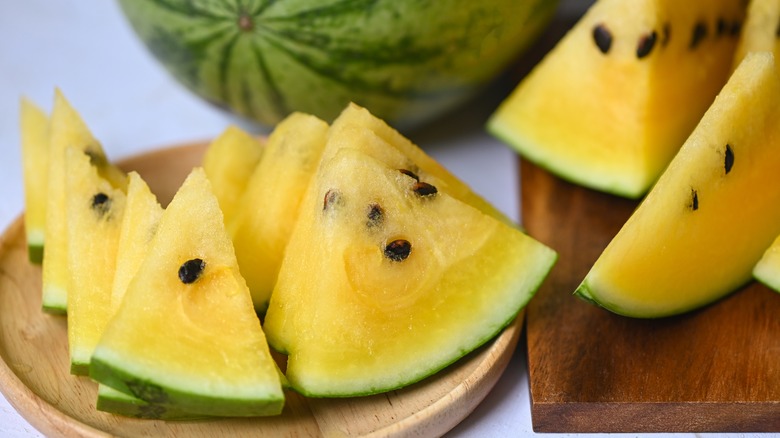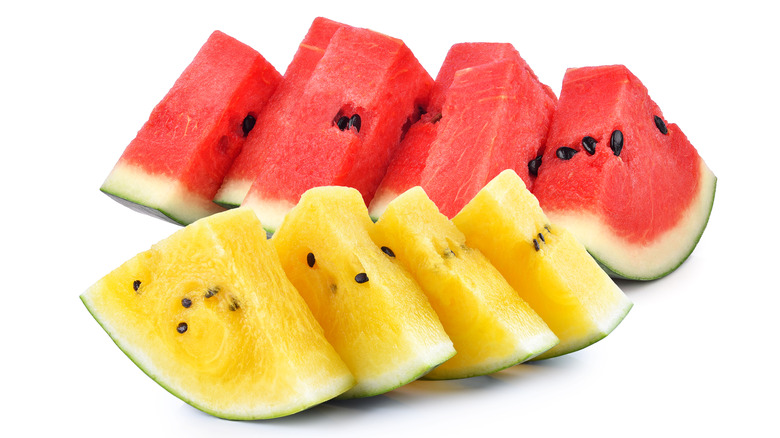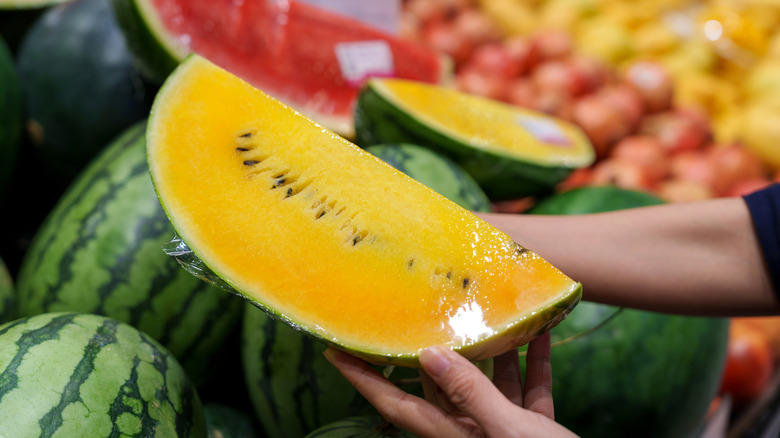Yellow Watermelon Vs. Red Watermelon: Can You Taste A Difference?
What could be more delicious and refreshing than a nice slice of watermelon? In addition to being a sweet and tasty treat, watermelon is a great way to stay hydrated beyond drinking water, and it's also a great source of vitamin C, vitamin A, and fiber. While almost everyone is familiar with watermelon in its vibrant red form, fewer people are aware of the fruit's yellow variety.
Yellow watermelon has a lot in common with its red relative, but there are some minor differences between the two fruits. Knowing what to expect from a bite might help you decide if you want to try something a bit more unique. Yellow watermelon is slightly sweeter than its red counterpart and has a honey-like flavor with notes of apricot. Conversely, red watermelon is tangier with notes of cucumber. The two melon varieties also have different textures, with yellow having denser, less watery flesh than red.
There are several different varieties of yellow watermelon, including Yellow Crimson, which is a sweeter version of the red variety Crimson Sweet, and Mountain Sweet Yellow, which can weigh more than 25 pounds per melon! No matter which variety you select, yellow watermelon is a juicy, refreshing, and healthy snack, although it does have slightly different nutritional benefits than red watermelon.
What are the health benefits of yellow watermelon?
Yellow watermelon's honey-like flavor isn't the only thing that sets it apart from the more popular red kind. The reason for yellow and red watermelon's different colors is also what affects their nutritional benefits. Lycopene, the antioxidant responsible for red watermelon's striking color, is missing from yellow watermelon. Also found in other red and pink produce like tomatoes and grapefruit, lycopene may protect against certain forms of cancer due to its ability to prevent damage from free radicals.
Not to be outdone by its red relative, yellow watermelon gets its color from beta-carotene. The human body converts this pigment, which is also present in foods like butternut squash and yellow peppers, into vitamin A, a powerful anti-inflammatory and antioxidant that's good for the eyes, bones, and immune system. While red watermelon also has vitamin A, yellow watermelon actually has more of it. Both red and yellow watermelon are healthy snack ideas you can feel good about, as they're delicious, nutritious, and stave off the heat on summer days.
Where to find yellow watermelon
Yellow watermelon can be a bit tricky to find, but major grocery chains like Kroger and Trader Joe's sometimes stock it, especially during the summertime. Yellow watermelon is in season from May through September, so you might find this uncommon fruit to try at your local supermarket or farmer's market during the spring, summer, and early fall. One thing to note when searching for yellow watermelon is that it looks exactly the same as a red melon on the outside. If you're looking for a whole melon, grocers will typically have a sign to let customers know the difference between the two varieties.
Just like with red watermelon, you can determine whether a yellow watermelon is ripe with a couple of simple tests. A ripe watermelon will feel heavier due to its high water content and will make a hollow sound when you tap on it. Also, avoid flaws like cuts or scrapes on the skin, or lumps and soft spots when you feel the rind.


